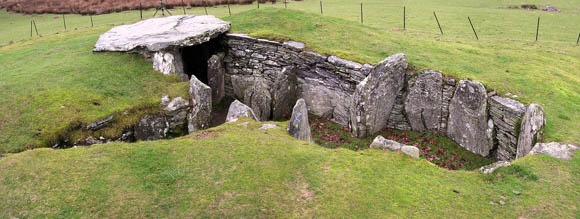|
Bettws-Garmon - From 'A Topographical Dictionary of Wales' (1849)
BETTWS-GARMON, a parish, in the hundred of Isgorvai, union and county of Carnarvon, North Wales, 5 miles (S. E.) from Carnarvon, on the road to Bethgelart; containing 111 inhabitants. The scenery in this neighbourhood is magnificently grand, and strikingly varied. Part of the base of Snowdon is within the parish, and previously to the formation of the new line of road to Llanberis and Capel Curig, the principal ascent to that mountain was from this place, where a guide is still constantly in attendance to conduct the adventurous traveller to the summit. Behind the church is the mountain Moel Aelian, which rises to the height of 2377 feet above the level of the sea; and on the south of it is Mynydd Mawr, of less elevation, but seen to greater advantage from the road. Both these mountains abound with copper-ore, and they were lately excavated with considerable success; but the want of capital caused the discontinuance of the works, although it is said there are not more promising mines in the principality. On the summits of the two mountains are the remains of watch-towers, or exploratory stations, erected to defend the pass; and at the foot of Mynydd Mawr is a bold rock, called Castell Cidwm, supposed to have been the abode of some ancient British chieftains. The abrupt and mountainous elevations which form so prominent a feature in the scenery, are finely softened and contrasted by the lakes in the parish, which are much resorted to by tourists and by artists, who find in the beautiful scenery around them some of the finest subjects for the pencil. Of these, the principal are Fynnon Lâs, Llyn Côch, Llyn-y-Nadroedd, and Llyn Fynnon-yGwâs, forming the several sources of the river Avon, or Tarddeni. Llyn Cwellyn, one of the most celebrated lakes in this part of the principality, and one of the two in Wales containing char, is partly within the parish; in which also is Nant Mill, remarkable for its beautiful cascade. Fairs are held on August 17th and September 22nd and 26th.
The living, usually styled a perpetual curacy, is vicarial, and is endowed with £600 royal bounty and £200 parliamentary grant; net income, £62. 10.; patron, the Bishop of Bangor; impropriator, Lord Newborough. The great tithes have been commuted for a rent-charge of £16. 13. 1½., and those payable to the perpetual curate for one of £14. 6. 4. The church, dedicated to St. Garmon, and romantically situated in a vale bounded by lofty mountains, has been rebuilt under the superintendence of Mr. George Alexander, architect, of London, at an estimated expense of £350, chiefly received from persons unconnected with the parish. It is a neat small edifice, surmounted by a belfry and cross, with a two-light window beneath. There is a place of worship for Calvinistic Methodists, with a Sunday school held in it. On the side of a hill, about one mile west of the church, is a fine spring of water, called St. Garmon's well, of reputed efficacy in the cure of rheumatic and eruptive disorders.
|

